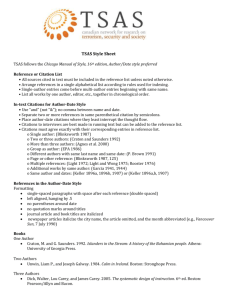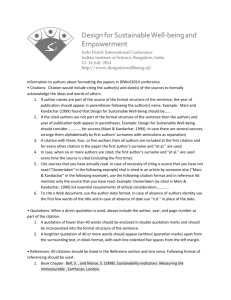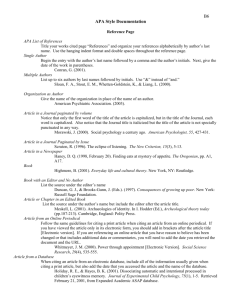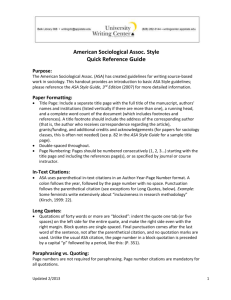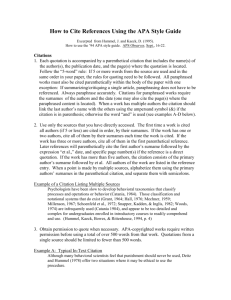SJPP Style Guide
advertisement
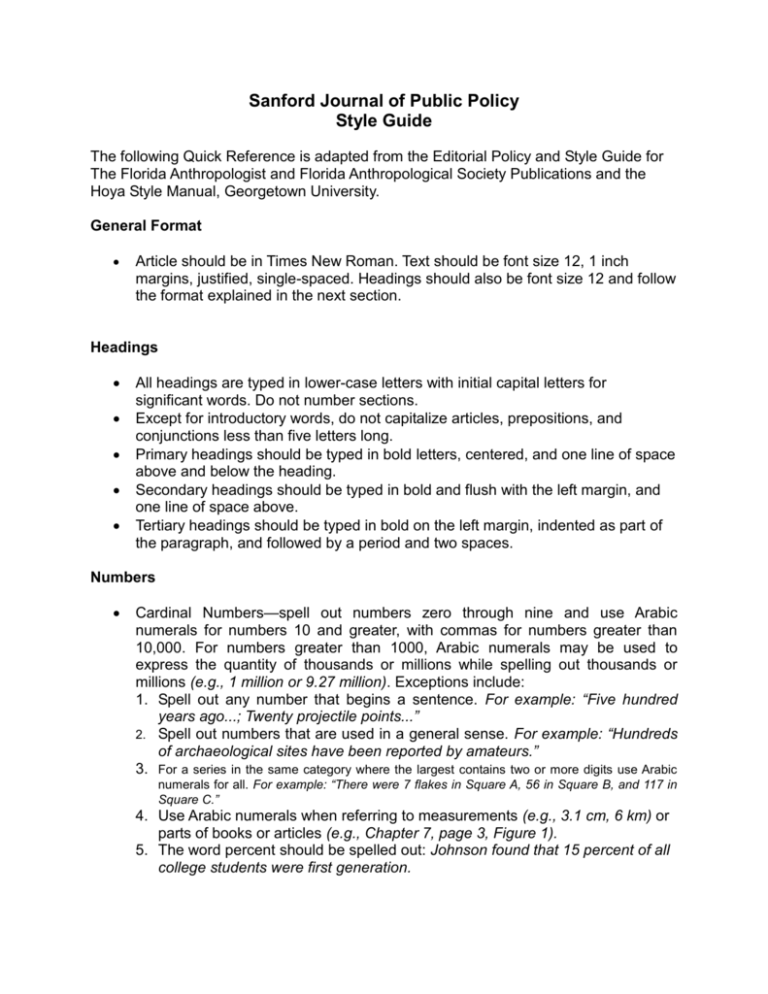
Sanford Journal of Public Policy
Style Guide
The following Quick Reference is adapted from the Editorial Policy and Style Guide for
The Florida Anthropologist and Florida Anthropological Society Publications and the
Hoya Style Manual, Georgetown University.
General Format
Article should be in Times New Roman. Text should be font size 12, 1 inch
margins, justified, single-spaced. Headings should also be font size 12 and follow
the format explained in the next section.
Headings
All headings are typed in lower-case letters with initial capital letters for
significant words. Do not number sections.
Except for introductory words, do not capitalize articles, prepositions, and
conjunctions less than five letters long.
Primary headings should be typed in bold letters, centered, and one line of space
above and below the heading.
Secondary headings should be typed in bold and flush with the left margin, and
one line of space above.
Tertiary headings should be typed in bold on the left margin, indented as part of
the paragraph, and followed by a period and two spaces.
Numbers
Cardinal Numbers—spell out numbers zero through nine and use Arabic
numerals for numbers 10 and greater, with commas for numbers greater than
10,000. For numbers greater than 1000, Arabic numerals may be used to
express the quantity of thousands or millions while spelling out thousands or
millions (e.g., 1 million or 9.27 million). Exceptions include:
1. Spell out any number that begins a sentence. For example: “Five hundred
years ago...; Twenty projectile points...”
2. Spell out numbers that are used in a general sense. For example: “Hundreds
of archaeological sites have been reported by amateurs.”
3. For a series in the same category where the largest contains two or more digits use Arabic
numerals for all. For example: “There were 7 flakes in Square A, 56 in Square B, and 117 in
Square C.”
4. Use Arabic numerals when referring to measurements (e.g., 3.1 cm, 6 km) or
parts of books or articles (e.g., Chapter 7, page 3, Figure 1).
5. The word percent should be spelled out: Johnson found that 15 percent of all
college students were first generation.
Ordinal Numbers—these are always spelled out. For example: “The thirty-fifth
anniversary issue of The Florida Anthropologist...; the sixteenth century...; the
first example....” An exception is the use of ordinal numbers to refer to papers
presented at annual meetings in the References Cited section. For example:
“Paper presented at the 45th annual meeting of the Florida Anthropological
Society....”
Dates—they should be expressed as in the following examples: 450 years; on
April 1, 1996; in the sixteenth century (not 16th); during the 1850s (not 1850’s or
fifties); from 1527-1540 (not 1527-40). The designation A.D. (anno Domini)
should be placed before a date using the Christian chronology, not after (e.g.,
A.D. 500-600). The designations B.C. (before Christ) should be placed after the
numbers used to designate dates which predate the Christian era (e.g., 800-500
B.C.). Alternatively, the number for the year followed by the designation B.P.
(before Present) may also be used.
All mathematical or statistical variables should be italicized or underlined (e.g., F
= 12.67; df = 1, 12; p = .05). Never use leading zeros in text, figures, or tables.
Mathematical equations should be set off from the text by spaces above and
below the equation or formula, and centered. For example:
N (S - 1)2 + (2N - S)
Quotations
Quotations of fewer than five typewritten lines should be included in the text
enclosed in quotation marks.
All quotations require a citation. If the name(s) of the author(s) is included in the
sentence that includes the quotation, then the year and page number(s) should
be placed in parentheses following the author’s name. If the author’s name is not
included in the text, then the name(s), year of publication, and page number(s)
should be placed in parentheses after the quotation. For example: According to
Tesar (1980:246), “following the DeSoto expedition in 1540 and prior to...” or The
Late Archaic “...was a time of considerable population growth, clear regional
adaptations, and interregional exchange of raw materials” (Griffin 1967:178).
Quotations of more than five typewritten lines should be set off from the text in a
block quote, without quotation marks, double spaced, with two lines above and
below.
Hyphenation
For rules governing hyphenation of compound words, consult Webster’s New
Collegiate Dictionary.
Compound words are spelled without hyphens if they can be considered
permanent combinations (e.g., postclassic, precolumbian, Paleoindian, but midPleistocene, post-Archaic, etc.).
Prefixes in common use are not hyphenated (e.g., noncultural, reanalyze,
intrasite).
Hyphenate combinations of words that serve an adjectival function (e.g., checkstamped pottery, heat-treated lithics, use-wear analysis).
Do not hyphenate a combination of an adverb ending in -ly plus a participle or
adjective (e.g., highly developed species, poorly drained soil).
In-text Citations
References, including references to personal communications, are placed in the
body of the text, not in notes at the bottom of the page or following the article.
The typical citation includes the author(s) last name(s) followed by the year of
publication and, where necessary, the page or page numbers. For example:
When (Willey 1949), Willey (1949), or Willey (1949:345-347).
Parentheses are used to enclose the citation except when used with text material
that is set off in parentheses or with quoted text material that has been set off as
a block quote, in which case the citation is enclosed in brackets.
Three or more authors are designated by the use of “et al.” after the first author’s
name. For example: (Milanich et al. 1984) or Milanich et al. (1984). The use of “et
al.” is limited to text citations; all of the authors’ names must be listed in the
References Cited section.
When several different authors are referenced in a citation, the authors should be
listed in alphabetical order with the works of different authors separated by
semicolons. For example: (Bullen 1975; Carr et al. 1995; Deagan 1979; Luer and
Almy 1982; Milanich 1972, 1994). Note that two or more works by a single author
or authors are separated by a comma.
Two or more references by an author or authors in a single year are designated
by lower case letters (e.g., Lee 1995a, 1995b).
All citations should provide a date if possible. The use of “n.d.” or “ms.” should be
kept to a minimum and are used only to refer to unpublished works where a date
of completion is impossible to determine.
Personal communication includes written or spoken correspondence to the
author, and should also include a date. For example (Sam Upchurch, personal
communication, 1993) or Sam Upchurch (personal communication, 1993).
Personal communications are not included in the References Cited section.
References to publications by government agencies, private companies, or other
organizations should include the full name of the organization in the citation
along with the year of publication and page numbers, if necessary. If the citation
will occur more than once, then an abbreviated acronym may be placed in
brackets following the first full citation and these abbreviations may be used
thereafter. For example: (United States Army Corps of Engineers [USA COE]
1991) and (USA COE 1991) or USA COE (1991).
When figures, maps, or tables are included in a citation these words are spelled
out. For example: (Purdy 1981:Figure 2) not (Purdy 1981:Fig. 2). Do not include
the page number on which the figure, map, or table occurs unless there is
additional information on the page that should be cited as well.
Punctuation
apostrophe (')
-For plural nouns ending in s, add only an apostrophe: the girls' toys, states'
rights.
-For singular common nouns ending in s, add 's: the hostess's invitation, the
witness's answer.
-For singular proper names ending in s, use only an apostrophe: Descartes'
theories, Kansas' schools.
-For singular proper names ending in s sounds such as x, ce, and z, use 's:
Marx's theories, the prince's life.
-For plurals of a single letter, add 's: Mind your p's and q's, the Red Sox
defeated the Oakland A's.
-Do not use 's for plurals of numbers or multiple letter combinations: the
1980s, RBIs
colon (:)
-Capitalize the first word after a colon only if it is a proper noun or the start of
a complete sentence. Examples: He promised this: The company will make
good all the losses. There were three considerations: expense, time and
feasibility.
-Colons go outside quotation marks unless they are part of the quoted
material.
semicolon (;)
- A semicolon can be used in place of a period to separate two related
sentences where the conjunction has been left out. Example: Call me
tomorrow; I will give you my answer then.
- Use a semicolon before introductory words such as namely, however,
therefore, that is, for example, or for instance when they introduce a complete
sentence. Use a comma after the introductory word. Example: You will want
to bring many backpacking items; for example, sleeping bags, pans, and
warm clothing will make the trip better.
- Use a semicolon to separate units of a series when one or more of the units
contain commas. Example: This conference has people who have come from
Boise, Idaho; Los Angeles, California; and Nashville, Tennessee.
- Use the semicolon between two sentences joined by a coordinating
conjunction when one or more commas appear in the first sentence.
Example: When I finish here, I will be glad to help you; and that is a promise I
will keep.
comma (,)
-Use the oxford comma: a comma immediately before the coordinating
conjunction (usually and, or, or nor) in a series of three or more terms.
Parentheses
-The perceived need for parentheses is an indication that your sentence is
becoming contorted. Try to rewrite the sentence, putting the incidental
information in commas, dashes or in another sentence. If you do use
parentheses, follow these guidelines:
-If the material is inside a sentence, place the period outside the
parentheses.
-If the parenthetical statement is a complete independent sentence, place
the period inside the parentheses.
Period
-Use a single space after the period at the end of a sentence.
-Do not put a space between initials: C.S. Lewis; G.K. Chesterton.
Quotation marks (“ ”)
-Periods and commas always go within quotation marks.
-Dashes, semicolons, question marks and exclamation points go within the
quotation marks when they apply to the quoted material. They go outside
when they apply to the whole sentence.
Capitalization
Titles
Movies: Casablanca
Books: On the Road
Plays: “Death of a Salesman”
Operas: “The Magic Flute”
Newspapers: The Wall Street Journal, The Washington Post
Magazines: Maxim, Time Magazine
TV Shows: “The West Wing”
Episode Titles: “The Dead End”
Music Albums: Jagged Little Pill
Song Titles: “Imagine”
Games: “Star Wars: Knights of the Old Republic”
Of places:
-Lowercase compass directions: The warm front is moving east.
-Capitalize names of U.S. regions: The Northeast depends on the Midwest for
its food supply.
-The “Middle East” applies to Afghanistan, Cyprus, Egypt, Iran, Iraq, Israel,
Kuwait, Jordan, Lebanon, Oman, Qatar, Saudi Arabia, South Yemen,
Sudan, Syria, Turkey, United Arab Emirates and Yemen. The term is
preferable to “Mideast.”
Of seasons:
Lowercase “spring,” “summer,” “fall” and “winter” and derivatives such as
“wintertime” unless part of a formal name: I love Paris in the springtime;
the Winter Olympics
That & Which
“That” should always be used when a comma is not present. “Which” should only
be used if a comma directly precedes the word. For example: “He hated the dog that bit
him on his postal route each morning.” “She loved red roses, which she had grown in
her garden as a small child.”
Figures & Tables
All illustrative material (i.e., maps, photographs, illustrations, graphs) are referred
to as “Figures.”
Use Arabic numerals and number all figures sequentially in the order that they
appear in the text. Provide a concise description for each figure, in complete
sentences, using sentence-style capitalization. For example: Figure 1. Map of the
excavation area showing the distribution of decorated sherds.
Use Arabic numerals and provide a short, descriptive title for each table using
sentence capitalization. For example: Table 1. Cross-tabulation of raw material by
functional use wear.
Notes
Endnotes are inserted at the end of the text, using a secondary head.
Endnotes should be used judiciously and be limited to essential information
required for clarification when inclusion of that information in the text would prove
disruptive to the flow of the manuscript or would be tangential to the discussion in
progress.
Endnotes do not include references.
Footnotes are not accepted.
References Cited
Use APA format.
It includes only the publications that are cited in the text; i.e., it is not a
bibliography. All entries must be listed alphabetically by the last name of the
senior author, and chronologically for two or more entries by the same author(s).
Use the names as they appear on the publication; i.e., do not abbreviate first or
middle names unless they appear as abbreviations on the publication. All
authors’ names are included; do not use “et al.” or “and others.”
